Cirrus Scores A History-Making "First" ...Again
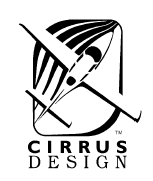 Despite temps that hovered
between "Oh My God" and "Close The Damned Door!" (in other words,
about 10 degrees below zero), Cirrus has delivered the first two
Avidyne Entegra equipped SR22s to two very lucky new owners (both
of whom are destined to become our new best friends...).
Despite temps that hovered
between "Oh My God" and "Close The Damned Door!" (in other words,
about 10 degrees below zero), Cirrus has delivered the first two
Avidyne Entegra equipped SR22s to two very lucky new owners (both
of whom are destined to become our new best friends...).
Fully certified and ready for action, the first two production
Cirrus SR22’s, featuring Avidyne FlightMax Entegra, 10.4 inch
horizontal Primary Flight Displays were delivered to David Bushman
(second photo, below) of Crownsville, MD and Greg Waits (third
photo, below) of Suwanne, GA. Bushman remarked, “It is a
dream come true just to get the SR22, but then Cirrus phoned to say
we are one of the first to receive the Entegra as well. My wife and
I are excited beyond belief.”
The decision to only offer a large, horizontal display was
determined even before the development of the SR20. Intro'd at
Oshkosh 2002, and carrying an added price of only $24,500, the
new option rapidly became popular with SR22 customers, with some
customers delaying delivery so as to incorporate the PFD into their
configurations.
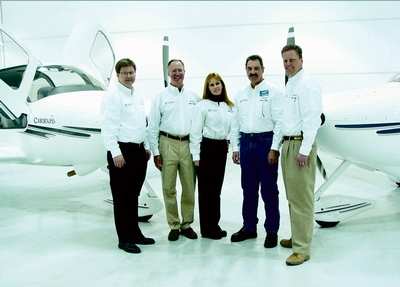
According to Greg Waits, the decision to purchase the aircraft
incorporating the new option before certification was an easy
decision, “It is essential for me to know that my plane has
the latest in technology, and the Entegra PFD provides additional
redundancy, which for me is also important.”
The FAA Aircraft Certification Office (ACO) in Chicago imposed a
rigorous certification program on Avidyne and Cirrus, however were
supportive of their efforts in principle. Patrick Waddick, VP
Engineering for Cirrus stated, “This was an excellent example
of a successful, cooperative endeavor between a government agency
and private enterprise. They were methodical but helpful throughout
development and certification. We appreciate their
efforts.”
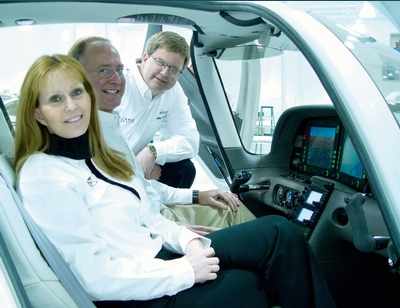
So... What's The Fuss?
The Cirrus decision process to make airplanes equipped with a
“glass cockpit” began long before any of the Cirrus
airplanes were certified. Introducing that reality to general
aviation today raises some questions that Cirrus people seem to
have have thought about extensively.
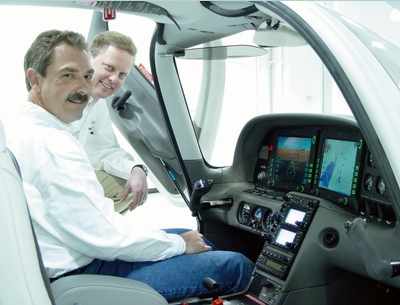
Why haven’t General Aviation aircraft had glass cockpits
before?
Cost has been the big driver. Originally developed for military
and commercial aviation applications, unit costs measured in
hundreds of thousands of dollars prohibited general aviation
manufacturers from incorporating them into their airplanes.
In recent years low cost “solid state gyros,”
commercially available “glass,” modern software
development tools and an enlightened certification environment have
made the cost more realistic. At this point they’re not cheap
(at $48,000 for a screen and associated sensors) but it’s
do-able. It’s interesting that, in a new airplane, Cirrus can
offer this item for under $25,000 – indicating how many
earlier generation electro-mechanical instruments are replaced.
What are the advantages of the “screens” over the
tried and true instruments?
First, those “tried and true” instruments fail a lot
(just check the stats on vacuum pump failures, alone... it's
scary). In the airline and business jet arenas, where this
technology originated, the primary reason for introducing these
types of cockpits was reliability – giving better dispatch
rates and customer satisfaction. Benefits such as ease of use and
quicker learning were secondary at best. Experienced, ATP licensed
crews, flying almost daily and having regular (company or FAA)
flight checks probably meant that safe operations could be carried
out regardless.
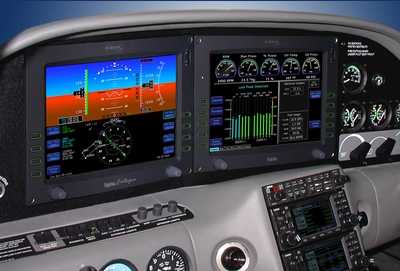
In the smaller, owner flown, personal transportation arena,
pilots rarely amass the flight time and achieve the currency
experienced by professional pilots. The “glass
cockpit” plays a different role here – easy to fly and
hard to misinterpret. In fact, the idea was to avoid interpretation
at all and simply make the “view” through the
“glass window” analogous to the view out of the
aircraft windshield. It only requires flying with a new pilot
to see how they take to this new way of “instrument
flying,” to truly appreciate just how much easier it is.
Combine this with the MFD (multi-function display)
showing you where you are on your flight and, perhaps,
relevant weather and traffic information, and you get the
best-informed pilot in the business. Better informed, means better
decisions. Better decisions mean safer flights. And it also means
that it’s MUCH easier to learn the intricacies of instrument
flight.
Why does Cirrus use the landscape (or horizontal) layout for
the screens when most airline and business jet installations use
portrait (or vertical) screens?
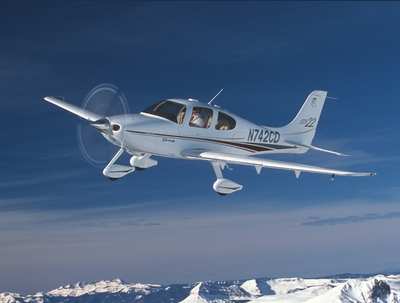
It all has to do with the horizon and the inexperienced and/or
less current (at least in airline terms) pilots flying (or learning
to fly) general aviation airplanes. It is rare for a pilot to
lose control of an airplane flying VFR on a nice day. The visual
horizon line is infinitely wide and perfectly clear. But pilots,
particularly those with little instrument experience, do lose
control in the clouds with the classical 3-inch attitude
instrument. With tragic regularity...
The idea then becomes to present the widest horizon
possible and create a compelling display that simply can’t be
ignored no matter what else you may be doing in the cockpit
(with the exception of Mile-High Club applicants...).
You can easily see the smallest attitude
change. In fact, you can’t miss changes in attitude,
if you try!
That’s also why Cirrus chose to only use the
widest possible display (the landscape format) and
to portary the horizon line through all the other
displays.
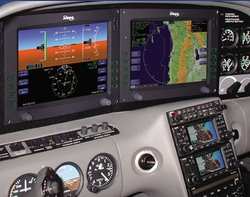
So... is the width of a 10-inch screen as good as the natural,
VFR horizon?
Maybe, maybe not – but it seems a lot better than
the couple of scant inches offered up on a classical general
aviation attitude indicator. By far...
 ANN's Daily Aero-Term (12.19.25): Ultrahigh Frequency (UHF)
ANN's Daily Aero-Term (12.19.25): Ultrahigh Frequency (UHF) NTSB Prelim: Cirrus Design Corp SR22T
NTSB Prelim: Cirrus Design Corp SR22T Classic Aero-TV: The Red Tail Project--Carrying the Torch of the Tuskegee Airmen
Classic Aero-TV: The Red Tail Project--Carrying the Torch of the Tuskegee Airmen Aero-News: Quote of the Day (12.19.25)
Aero-News: Quote of the Day (12.19.25) Airborne 12.17.25: Skydiver Hooks Tail, Cooper Rotax Mount, NTSB v NDAA
Airborne 12.17.25: Skydiver Hooks Tail, Cooper Rotax Mount, NTSB v NDAA









